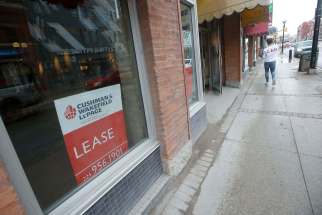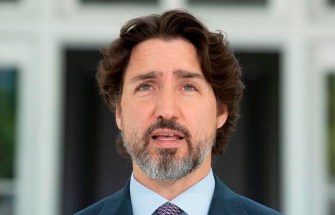Business leaders urge Pallister to redirect unused COVID-assistance program dollars
Read this article for free:
or
Already have an account? Log in here »
To continue reading, please subscribe:
Monthly Digital Subscription
$0 for the first 4 weeks*
- Enjoy unlimited reading on winnipegfreepress.com
- Read the E-Edition, our digital replica newspaper
- Access News Break, our award-winning app
- Play interactive puzzles
*No charge for 4 weeks then price increases to the regular rate of $19.00 plus GST every four weeks. Offer available to new and qualified returning subscribers only. Cancel any time.
Monthly Digital Subscription
$4.75/week*
- Enjoy unlimited reading on winnipegfreepress.com
- Read the E-Edition, our digital replica newspaper
- Access News Break, our award-winning app
- Play interactive puzzles
*Billed as $19 plus GST every four weeks. Cancel any time.
To continue reading, please subscribe:
Add Free Press access to your Brandon Sun subscription for only an additional
$1 for the first 4 weeks*
*Your next subscription payment will increase by $1.00 and you will be charged $16.99 plus GST for four weeks. After four weeks, your payment will increase to $23.99 plus GST every four weeks.
Read unlimited articles for free today:
or
Already have an account? Log in here »
Hey there, time traveller!
This article was published 28/05/2020 (1984 days ago), so information in it may no longer be current.
Two of Brian Pallister’s marquee COVID-19 assistance programs appear as though they will be largely underspent, prompting business leaders to suggest alternative uses for the money.
The provincial government has budgeted up to $120 million for each of the Summer Student Recovery Jobs Program and the Manitoba Gap Protection Program (MGPP).
Tool matches students, jobs
The provincial government launched an online tool today to match students with summer jobs.
Student Jobs MB aims to connect students looking for work opportunities with employers throughout the province, Premier Brian Pallister announced during a teleconference.
The provincial government launched an online tool today to match students with summer jobs.
Student Jobs MB aims to connect students looking for work opportunities with employers throughout the province, Premier Brian Pallister announced during a teleconference.
The free online program allows students to apply for multiple jobs with the click of a button. Private-sector employers, not-for-profit organizations and governments are able to post openings and connect directly with students. It expedites the hiring process and uses secure technology to protect user privacy, Pallister said.
“Summer jobs are important for youth in not only helping pay for an education, but for building life skills and developing future career interests,” he said. “Employers also benefit from hiring students who can bring energy and new perspectives to their operations and can assist them greatly in rebounding from the COVID-19 pandemic.”
The online tool is designed to complement the Summer Student Recovery Jobs Program launched April 24 in response to the economic impact of the pandemic. It supports employers in hiring high school and post-secondary students between the ages of 15 and 29 by making $120 million available for a $7 hourly wage subsidy, up to a maximum of $5,000 per student. Employers can be subsidized to hire up to five students.
To date, 793 employers offering 1,841 student jobs have responded to the program, a government news release said.
“I’d like to see that number go a lot higher,” Pallister said. “That’s what this announcement is about.”
Student Jobs MB will be the primary source used by the province to connect students with government employment opportunities offered through the Student Temporary Employment Program, the Conservation Green Team and Urban/Hometown Green Team partners.
More information on student and youth employment opportunities can be found at www.studentjobsmb.ca.
— Carol Sanders
The province says it has approved more than 4,000 applications for assistance under the MGPP, paying out more than $25 million so far.
Designed to fill in gaps left by federal COVID-19 subsidy programs for business, the program provides forgivable loans of up to $6,000 for small and medium-sized businesses.
However, since the program was introduced in April, Ottawa has amended its assistance criteria, reducing the need for the less-generous provincial plan, business leaders say.
They say it’s now unlikely that the province will will have to expend significantly more money through the MGPP than it already has.
Jonathan Alward, director of provincial affairs with the Manitoba branch of the Canadian Federation of Independent Business, said the program was “very well-intentioned.”

There were several gaps in federal programming for business but Ottawa has addressed them to a significant degree, he said.
Some businesses that applied for the provincial program will likely apply for the improved Canada Emergency Business Account (CEBA) program, even if it means having to return the provincial funds, Alward said.
That means at least some of the $25 million the province has paid out so far will be returned to provincial coffers.
Neither Alward, nor Chuck Davidson, president and CEO of the Manitoba Chambers of Commerce, believe many more businesses will apply for the MGPP now that Ottawa has improved its programs.
Alward said the CFIB is lobbying the province to introduce new business supports in lieu of the tens of millions of dollars allocated for the MGPP that will go unspent.
He said the cash could be used to assist businesses in purchasing personal protective equipment and help cover staffing and other costs dedicated to ensuring the safety of employees and customers.
To date, 793 employers have applied for government wage assistance under the province’s Summer Student Recovery Jobs Program to hire 1,841 students this summer, Pallister said Thursday, as he announced the establishment of an online tool to help match employers with students looking for work.
The program, launched over a month ago as a key provincial response to the economic impact of the pandemic, provides an hourly wage subsidy of $7 to a maximum of $5,000 per student. So far, if the maximum amount were paid out to each student enrolled, the total cost would be about $9.2 million.
Davidson said even with restrictions on many businesses scheduled to loosen Monday, there will be far fewer jobs available to students than has been the case previously in the hospitality, tourism and service sectors.
Pallister denies using pandemic for political gain
Premier Brian Pallister is denying suggestions that he was attempting to use the COVID-19 pandemic as a way to gain political advantage in the funding of post-secondary institutions.
“That’s a gross misrepresentation of the reality that we have to face,” he told reporters on a conference call Thursday.
The Progressive Conservative government forced post-secondary institutions to trim their budgets, then surprised them by unveiling a $25.6-million “transitional support fund” to push them to adjust to the job market.
Premier Brian Pallister is denying suggestions that he was attempting to use the COVID-19 pandemic as a way to gain political advantage in the funding of post-secondary institutions.
“That’s a gross misrepresentation of the reality that we have to face,” he told reporters on a conference call Thursday.
The Progressive Conservative government forced post-secondary institutions to trim their budgets, then surprised them by unveiling a $25.6-million “transitional support fund” to push them to adjust to the job market.
So far, the province hasn’t provided much detail on what adjustments it is seeking from the colleges and universities. However, in an internal memo to University of Manitoba staff, president David Barnard said Thursday the institution has been asked to submit proposals for funding by Sept. 15.
Pallister said that in several other provinces and in much of the United States, “there are structures in place to partner post-secondary institutions more effectively with the economies that support them and pay for them. This is what we’re after.”
Told Thursday of criticism from professors about the funding changes, Pallister said institutional leaders such as Barnard and University of Winnipeg president Annette Trimbee have been “tremendously supportive” of the government’s initiative.
“This is an opportunity to help our post-secondary institutions work better, to be more effective in training people, helping people to move forward,” he said.
“It’s an opportunity to be embraced…. If some tenured professors don’t want to embrace the opportunity, I think that simply strengthens the argument that their ivory tower attitude is counterproductive to the best interests of the rest of us.”
— Larry Kusch
“Those are the industries that, for the most part, have been either operating at half-capacity or haven’t even had the opportunity to operate yet,” he said.
Owners will be unsure how the public is going to respond to the reopening, he said.
“I would be surprised if they used that full $120 million,” Davidson said, referring to the money budgeted for the program.
The province’s chambers of commerce also have ideas for how the unused money could be spent.
“We think there’s going to be a need in regards to digital infrastructure investment in this province, which is going to be absolutely critical going forward,” Davidson said, citing one example.
Pallister said Thursday he’s hoping to see greater use of the summer student wage program.
“Employers can benefit from hiring students. I encourage small businesses to do this. I know that some of you are facing challenges attracting people back who have been in receipt of federal support programs,” he said.
Asked if he was disappointed in the uptake so far, he responded, “No, not at all.”
larry.kusch@freepress.mb.ca
History
Updated on Thursday, May 28, 2020 6:11 PM CDT: Updates story to final version
Updated on Thursday, May 28, 2020 6:24 PM CDT: Adds photos







